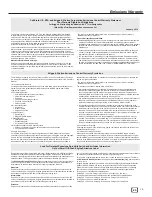
Not for
Reproduction
4
Operator Safety
WARNING
• Keep children out of the area during operation. Children are
often attracted to the equipment. Be mindful of all persons
present.
• Be alert and turn unit off if children enter the area.
• Never allow children to operate the unit.
• Use extra care when approaching blind corners, shrubs,
trees, or other objects that may obscure vision. Children
may be present.
Tragic accidents can occur if the operator is
not alert to the presence of children. Children
are often attracted to the unit and the operating
activity. Never assume the children will remain
where you last saw them.
Engines give off carbon monoxide, an
odorless, colorless, poison gas. Breathing
carbon monoxide can cause nausea, fainting,
or death.
WARNING
• Start and run engine outdoors.
• Do not run the engine in an enclosed area, even if doors or
windows are open.
• Keep fuel away from sparks, open flames, pilot lights, heat,
and other ignition sources.
• Check fuel lines, cap, and fittings frequently for cracks or
leaks. Replace if necessary.
• Use an approved fuel container.
• If fuel spills, wait until it evaporates before starting engine.
When Starting Engine
• Ensure that spark plug, muffler, fuel cap, and air cleaner (if
equipped) are in place and secured.
• Do not crank the engine with the spark plug removed.
• If fuel is spilled, do not attempt to start the engine, but move
the snowthrower away from the area of the spill, and avoid
creating any source of ignition, until the fuel vapors have
dissipated.
• Do not over-prime the engine. Follow the engine starting
instructions in this manual.
• If the engine floods, set choke (if equipped) to OPEN/RUN
position, move throttle (if equipped) to FAST position and
crank until engine starts.
When Operating Equipment
• Do not tip the snowthrower at an angle which causes the
fuel to spill.
• Do not choke the carburetor to stop the engine.
• Never run the engine with the air cleaner assembly (if
equipped) or the air filter (if equipped) removed.
When Changing Oil
• If you drain the oil from the top oil fill tube, the fuel tank
must be empty or fuel can leak out and result in a fire or
explosion.
When Transporting Equipment
• Transport with fuel tank EMPTY, or with fuel shut-off valve
OFF.
When Storing Gasoline or Equipment With Fuel in Tank
• Store away from furnaces, stoves, water heaters, or other
appliances that have pilot light or other ignition source
because they can ignite fuel vapors.
WARNING
When Adding Fuel
• Turn off engine and let cool at least 2 minutes before
removing the fuel cap and adding fuel.
• Fill fuel tank outdoors or in a well ventilated area.
• Do not overfill the fuel tank. To allow for the expansion of
gasoline, do not fill above the bottom of the fuel tank neck.
Fuel and its vapors are extremely flammable
and explosive. Always handle fuel with
extreme care.
Failure to observe these safety instructions can
cause a fire or explosion which will result in
severe burns or death.





































